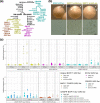Strain background of Candida albicans interacts with SIR2 to alter phenotypic switching
- PMID: 38446018
- PMCID: PMC10999749
- DOI: 10.1099/mic.0.001444
Strain background of Candida albicans interacts with SIR2 to alter phenotypic switching
Abstract
The genetic background between strains of a single species and within a single strain lineage can significantly impact the expression of biological traits. This genetic variation may also reshape epigenetic mechanisms of cell identity and environmental responses that are controlled by interconnected transcriptional networks and chromatin-modifying enzymes. Histone deacetylases, including sirtuins, are critical regulators of chromatin state and have been directly implicated in governing the phenotypic transition between the 'sterile' white state and the mating-competent opaque state in Candida albicans, a common fungal commensal and pathogen of humans. Here, we found that a previously ambiguous role for the sirtuin SIR2 in C. albicans phenotypic switching is likely linked to the genetic background of mutant strains produced in the RM lineage of SC5314. SIR2 mutants in a specific lineage of BWP17 displayed increased frequencies of switching to the opaque state compared to the wild-type. Loss of SIR2 in other SC5314-derived backgrounds, including newly constructed BWP17 sir2Δ/Δ mutants, failed to recapitulate the increased white-opaque switching frequencies observed in the original BWP17 sir2Δ/Δ mutant background. Whole-genome sequencing revealed the presence of multiple imbalanced chromosomes and large loss of heterozygosity tracts that likely interact with SIR2 to increase phenotypic switching in this BWP17 sir2Δ/Δ mutant lineage. These genomic changes are not found in other SC5314-derived sir2Δ/Δ mutants that do not display increased opaque cell formation. Thus, complex karyotypes can emerge during strain construction that modify mutant phenotypes and highlight the importance of validating strain background when interpreting phenotypes.
Keywords: Candida; aneuploidy; epigenetics; white opaque switching.
Conflict of interest statement
The authors declare that there are no conflicts of interest.
Figures



Similar articles
-
Genetic Analysis of Sirtuin Deacetylases in Hyphal Growth of Candida albicans.mSphere. 2021 May 5;6(3):e00053-21. doi: 10.1128/mSphere.00053-21. mSphere. 2021. PMID: 33952658 Free PMC article.
-
Ssn6 Defines a New Level of Regulation of White-Opaque Switching in Candida albicans and Is Required For the Stochasticity of the Switch.mBio. 2016 Jan 26;7(1):e01565-15. doi: 10.1128/mBio.01565-15. mBio. 2016. PMID: 26814177 Free PMC article.
-
Comparative genomics of white and opaque cell states supports an epigenetic mechanism of phenotypic switching in Candida albicans.G3 (Bethesda). 2021 Feb 9;11(2):jkab001. doi: 10.1093/g3journal/jkab001. G3 (Bethesda). 2021. PMID: 33585874 Free PMC article.
-
Regulation of white-opaque switching in Candida albicans.Med Microbiol Immunol. 2010 Aug;199(3):165-72. doi: 10.1007/s00430-010-0147-0. Med Microbiol Immunol. 2010. PMID: 20390300 Review.
-
The Roles of Chromatin Accessibility in Regulating the Candida albicans White-Opaque Phenotypic Switch.J Fungi (Basel). 2021 Jan 9;7(1):37. doi: 10.3390/jof7010037. J Fungi (Basel). 2021. PMID: 33435404 Free PMC article. Review.
References
Publication types
MeSH terms
Substances
Grants and funding
LinkOut - more resources
Full Text Sources

